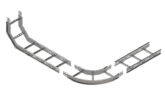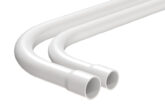
Univolt explains how corrosion is not just a problem for metal and that not all fibreglass is the same.
We are all familiar with the tendency of metal to rust. Look around any building and you will see rusting components which can often fail. This is caused by the oxidation reaction between the metal and the oxygen enabled by moisture and salts. But it is not just metal that suffers from corrosion. Many polymer products also deteriorate. In this case it is caused by sunlight.
As anyone who has spent a day in the sun without using sunscreen will know, the ultra violet (UV) element of the sun’s rays can be extremely harmful. In the case of organic-based polymers, such as the paint coatings on metals, PVC and fibreglass, UV can cause loss of colour, brittleness, blooming and in extreme cases mechanical failure. So, just as we protect metal from corrosion, it can be necessary to coat polymers with paint, wax or gel-coats to stop the degradation.
We consider degradation to be the process of material deterioration over time, leading to the compromising of the design intent. In the case of an enclosure this usually means that the equipment is no longer being protected from the elements, be that dust, moisture, or chemical attack. Or that the equipment is exposed to unauthorised access.
UV light and UV energy
With fibreglass, while it does have high levels of resistance to many corrosive chemicals, it is susceptible to UV light. What happens is that the UV energy breaks down the molecular bonds of the material, changing the chemical composition of the polymers. This leads to the surface of the fibreglass becoming yellow, cracked and flaky with reduced impact resistance and tensile strength.
While coatings can slow the process, they are only thin, which like the sunscreen we apply to our skin, loses its affect quite quickly. To counter this Stahlin, one of the leading US manufacturers of non-metallic enclosures, developed SolarGuard.

This uses a double protection formulation technology to significantly enhance the molecular bond strength and cross linking that occurs during the manufacturing process. It makes it much more difficult for UV light to attack molecular bonds of both primary chains and crosslinks. A special UV energy absorber is also added to the formulation which absorbs and then releases the UV energy without damaging the polymer chain.
The result is an improvement in its ability to retain gloss and colour after exposure to concentrated UV light of between 32% and 60%, compared to standard formulations. This is combined with excellent chemical resistance in both exposed vapour and total submersion applications.
The system also demonstrates limited surface spread of flame, with very limited toxic emissions or smoke in a fire which is considered to be non-halogenated. Making the enclosures ideal for use where there are people or enclosed spaces – transport terminals, sports stadia, theatres, cinemas and hospitals are some examples.
“The SolarGuard technology used for Stahlin enclosures makes them ideal for application where there will be continuous exposure to the sun’s UV rays.”
The SolarGuard technology used for Stahlin enclosures makes them ideal for application where there will be continuous exposure to the sun’s UV rays. They have been proven in dessert conditions in the oil fields of west Texas in the US as well as housing for inverters in solar farms, but also widely used to protect electrical equipment in plants, factories, ports and even at the side of our motorways.








